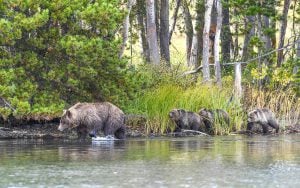
Wildlife
Do not disturb: Practicing ethical wildlife photography
Wildlife photographers on the thrill of the chase — and the importance of setting ethical guidelines
- 2849 words
- 12 minutes
Wildlife
The debut campaign launched by the Canadian Conservation Photographers Collective brings awareness to threats to wildlife from roads, railway transit, ocean transportation and air traffic
A female grizzly bear leads her three yearling cubs across a highway as a car threatens in the background; a humpback whale breaches off the B.C. coast, trailing foam and sea spray while a tugboat churns past; a snow goose extends its long white neck to view its surroundings on an airfield, blurry droplets of red, yellow and white runway lights in the distance.
Such is the nature of the arresting, albeit atypical, images on display in Crossing Paths, a new digital publication and the debut initiative from the Canadian Conservation Photographers Collective (CCPC). Part photo essay, part educational tool, Crossing Paths seeks to raise awareness about the destructive and harrowing impacts of public and commercial transportation on wildlife in Canada.
“This is a topic that deserves to be covered,” says Josh DeLeenheer, the CCPC’s B.C.-based founder and director. He notes that beyond the obvious impacts we see on roadways, there are many more threats to wildlife from transportation “that we don’t necessarily think about.”
Formed in 2021, the CCPC is run by a small team of volunteers and currently counts 35 photographers and videographers among its members. Its goal is to “shed light on pressing conservation issues,” draw attention to the solutions that exist, and to link its audience with others — collectives, NGOs, non-profits, research organizations and governments — that are engaged in these issues.
Crossing Paths brings together five transportation themes: roads and highways, railway transit, ocean transportation, air traffic and human activity on lakes and rivers. The photography, which depicts scenes of collision and conflict between wildlife and these fives modes of human transportation, drives the package, however DeLeenheer and his colleagues also researched the topics and brought in partner organizations to contribute educational content and to provide the audience with a means of taking further action.
“We wanted to have actionable goals,” DeLeenheer says. “We want to be able to direct our audience to these organizations that are already engaged in [finding solutions].”
For example, CCPC partnered with the Marine Education & Research Society (MERS) based in Port McNeill, B.C., for the section on ocean transportation. MERS is a registered charity that researches and promotes marine conservation. It campaigns to raise awareness about the harmful impacts of collisions and noise pollution from boat and ship traffic on marine wildlife — particularly, of late, humpback whales, recent returnees to B.C. waters whose behaviour and biology make them susceptible to collisions.
Jackie Hildering, MERS’ education and communications director, says participating in Crossing Paths offered an “an opportunity to amplify” its messaging about collision and noise impacts, as well as the urgent need for more ethical photography of marine animals — images that emphasize “how wild they are, not how close they are” — by media and ecotourism operators.
Given that Crossing Paths just launched, DeLeenheer says the team is still striving to raise its profile, leveraging the networks of its member photographers, partners and others. At the same time, they are also thinking about next steps — new campaigns, as well as working to secure non-profit status for the CCPC in 2024.
“This is our first campaign, so it’s a bit of an explanatory experience,” he says. But he’s hopeful the work and the CCPC’s mission will find a following. “I got into photography because of my passion for conservation. There’s so many stories on a local and national level that we can tell.”











Wildlife
Wildlife photographers on the thrill of the chase — and the importance of setting ethical guidelines

Wildlife
This past summer an ambitious wildlife under/overpass system broke ground in B.C. on a deadly stretch of highway just west of the Alberta border. Here’s how it happened.

People & Culture
These 10 members of Canadian Geographic’s online Photo Club are making waves with their unique perspectives on Canadian wildlife and landscapes

Wildlife
Canadian Geographic is pleased to honour 14 photographers for their outstanding images of Canadian wildlife